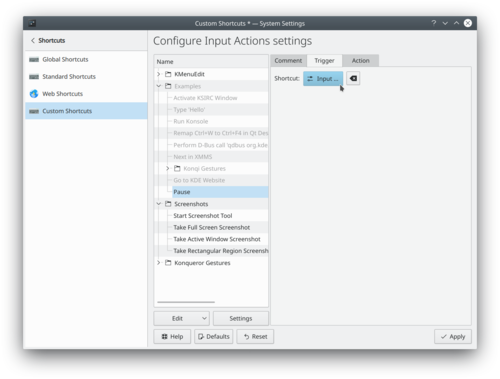Tutorials/hotkeys: Difference between revisions
Appearance
Marked this version for translation |
m formatting |
||
| Line 12: | Line 12: | ||
<!--T:4--> | <!--T:4--> | ||
* select <menuchoice>Shortcuts and Gestures | * select <menuchoice>Shortcuts and Gestures</menuchoice> → <menuchoice>Custom Shortcuts</menuchoice> → <menuchoice>Edit</menuchoice> → <menuchoice>New</menuchoice> → <menuchoice>Global Shortcut</menuchoice> → <menuchoice>Command/URL</menuchoice> and enter <code>Pause</code> | ||
<!--T:5--> | <!--T:5--> | ||
Revision as of 12:57, 20 April 2019
With KDE you can set any key or a combination of keys to trigger an action on your computer. As an example: when I pause my work I want to lock my screen with the Pause key so my colleagues cannot baggy-pants me. Here is how to do that.
- call the command
systemsettings
- select → → → → → and enter
Pause
- In the tab, click on
- press the Pause key
- go to the tab
- enter
qdbus org.kde.screensaver /ScreenSaver org.freedesktop.ScreenSaver.Lock
or (whatever works)
/usr/lib64/kde4/libexec/kscreenlocker_greet
or (whatever works)
/usr/lib64/kde4/libexec/kscreenlocker --forcelock
- click
- test it by pressing the Pause key

